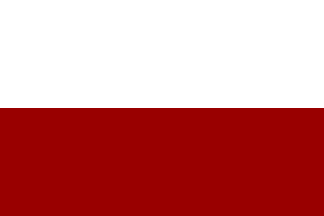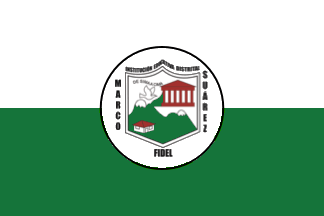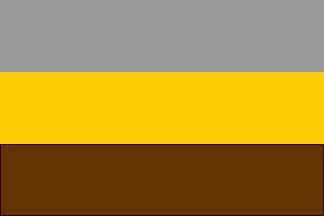 klaus-michael schneider
klaus-michael schneider
Keywords: education |
Links: FOTW homepage | search | disclaimer and copyright | write us | mirrors

Last modified: 2021-05-22 by  klaus-michael schneider
klaus-michael schneider
Keywords: education |
Links: FOTW homepage |
search |
disclaimer and copyright |
write us |
mirrors
![[Flag of Colombia]](../images/c/co.gif) (2:3)
(2:3)  image by Željko Heimer, 20 May 2001
image by Željko Heimer, 20 May 2001
See also:
 image by Ivan Sache, 17 September 2014
image by Ivan Sache, 17 September 2014
Escuela Marceliana Saldarriaga was established by Departmental Ordinance No.
36 of 13 December 1961 in El Guayabo borough, part of the municipality of Itagüí
(Antioquia Department). Colegio Marceliana Saldarriaga was established by
Departmental Ordinance No. 2,663 of 3 July 1996. Institución Educativa
Marceliana Saldarriaga was eventually established by Departmental Resolution No.
16,092 of 25 November 2002.
The flag of the institute is prescribed in Article 1.6.2 of the institute's
Etiquette Guidebook, as diagonally divided, per bend sinister, blue-red. Blue is
a symbol of the immensity and deepness of knowledge, and of the significance of
the proper academic space. Red is a symbol of life, love, and joy. The two
triangles represent the integration of the three pillars of the educational
community: students, educationalists, and parents.
Source:
http://www.iemarcelianasaldarriaga.edu.co/index2.php?id=12016&idmenutipo=1904&tag=
- Institute's website
Ivan Sache, 17 September 2014
 image by Ivan Sache, 13 October 2014
image by Ivan Sache, 13 October 2014
Institución Educativa Marceliano Polo was established in Cereté (Córdoba
Department) by Ordinance No. 19 of 21 October 1964, and nationalized in 1989.
The institute is named for the educationalist Marceliano Gabriel Polo Guerra
(1893-1961), who founded in the 1940s Colegio San Luis Gonzaga in Cereté.
The flag of the institute is prescribed in Article 5 of the institute's
Etiquette Guidebook as horizontally divided green-white-red. Green is a symbol
of hope; it represents savannah, woods, and pastures, and the fertility of the
Sinú and San Jorge valleys. White is a symbol of peace; it also represents
cotton. Red is a symbol of passion for study, joy, and aspiration to knowledge.
Source:
http://fr.slideshare.net/marcelianopolo/manual-de-convivencia-2012
Ivan Sache, 13 October 2014
"Colegio 'Marco Antonio Carreño Silva'" is located
in Bogotá.
The flag of the institute,
as shown graphically and described on the website
of the institute, is green with a white ascending diagonal
stripe and the emblem of the institute in the middle (represented
as a white disk on the drawing but explicitely mentioned in the
description). Green symbolizes hope and white the pacific common
life. The orientation of the stripe represents the constant
permanent and institutional improvement.
The emblem of the institute has a green border charged with the
three pillars of the institute, in white letters:
"AUTONOMÍA" (left), "PARTICIPACIÓN"
(right), and "CREATIVIDAD" (top), the flag of Bogotá
(horizontally divided yellow-red, without the coat of arms), and
the flag of the institute. The shield is blue, divided into three
parts by two green branches of laurel emerging from a single
stem, representing the fulfillment of the objectives proposed in
the institute. Above the branches are two open hands, symbolizing
unity and strength, on the left, a book, symbolizing science, on
the right a computer, representing access to knowledge through
technology, and under the stem the five Olympic rings,
symbolizing sociability, fraternity, equity, solidarity and
diversity.
Ivan Sache, 17 January 2009
 image by Ivan Sache, 1 February 2009
image by Ivan Sache, 1 February 2009
"Colegio 'Marco Fidel Suárez'" was created on 1
December 1967 (Decree No. 011) in Zulia, Departement of Norte del
Santander. The institute is named after Marco Fidel Suárez
(1855-1927), President of Colombia from 1918 to 1922, and also a
famous writer.
The flag of the institute, as shown graphically and described on
the website
of the institute, is white with two thin vertical green lines
near the host and another two near the fly, and the emblem of the
institute in the middle. White represents aspiration to peace
while green represents the ecological awareness of the community
of Zulia.
The emblem of the institute is diagonally divided yellow-red by a
red-orange ascending diagonal stripe charged with "Esfuerzo
y Triunfo" (Strength and Triumph) in black letters, a
reference to Marco Fidel Suárez' life . The yellow field is
charged with a white open book while the green part is charged
with a white torch hold by a hand.
Ivan Sache, 1 February 2009
 image by Ivan Sache, 02 December 2014
image by Ivan Sache, 02 December 2014
Institución Educativa Marco Fidel Suárez was established in Medellín
(Antioquia Department) by Resolution No. 16,287 of 27 November 2002 as
the merger of Liceo Nacional Marco Fidel Suárez, Escuela Cuarta
Brigada, Escuela Carlos Obando Velasco and Escuela La Iguaná.
The institute is named after Marco Fidel Suárez (1855-1927), President
of Colombia from 1918 to 1922, also a famous writer.
The flag of the institute is described in Article 1.2.1 of the
institute's Etiquette Guidebook as horizontally divided white-wine red.
White is a symbol of virtue, values, knowledge, purity, nobleness and
clarity.
Wine red is a symbol of union, friendship, permanency, constancy and
stimulation.
Source:
http://marcofidelsuarez.jimdo.com/institucional/manual-de-convivencia/
- Institute's website
Ivan Sache, 02 December 2014
 image by Ivan Sache, 27 July 2018
image by Ivan Sache, 27 July 2018
The symbols of Institución Educativa Distrital Marco Fidel Suárez are
presented in the school's Manual de Convivencia as follows:
The flag is
composed of two horizontal stripes of equal size, white in the upper part and
green in the lower part. [The companion image includes the school's coat of arms
placed on a white disk fimbriated in black]. White means the beauty and purity
of all people who join our educational community. Green means the aspiration to
grow in physical, humanist and intellectual transcendence at the local,
regional, national and international levels.
The coat of arms highlights
the life of Marco Fidel Suárez (a philosopher, poet and writer, 1855-1927; 9th
President of Colombia, 1918-1921). The hut is a symbol of humility. The dove, a
symbol of peace, flies from peak to peak in an ascending flight; indicating
permanent effort and advance in scientific knowledge. The Greek columns are a
symbol of love and respect of wisdom.
https://convivenciacomarfisu.files.wordpress.com/2012/01/manual-marfisu1.pdf
Manual de Convivencia
Ivan Sache, 27 July 2018
 image by Ivan Sache, 17 October 2014
image by Ivan Sache, 17 October 2014
Institución Educativa Marco Tobón Mejía was established on 6 June 2010
in Santa Rosa de Osos (Antioquia Department), separating from
Institución Educativa Cardenal Aníbal Muñoz Duque.
The institute is named for the Santa Rosa de Osos-born sculptor and
painter Marco Tobón Mejía (1876-1933), who spent most of his artistic
life in Paris, where he met Auguste Rodin, Aristide Maillol, and
Antoine Bourdelle.
The flag of the institute is prescribed in Chapter 2.3.2. of the
institute's Etiquette Guidebook as horizontally divided silver gray-
golden yellow-coffee brown.
Gray is the colour of integrity, work, victory, conscience, and force.
Yellow is the colour of light, constancy, and knowledge.
Brown is the colour of Mother Earth, symbolizing admiration and care
for the natural environment.
The colours of the flag are derived from the institute's coat of arms.
Source:
http://iemarcotobon.edu.co/images/manual-convivencia/manual-convivencia-2013.pdf - Institute's website
Ivan Sache, 17 October 2014
 image by Ivan Sache, 06 October 2014
image by Ivan Sache, 06 October 2014
Institución Educativa María Antonia Penagos was established in Palmira (Valle
Department) by Resolution No. 1,790 of 4 September 2002, as the merger of
Instituto de Educación Basica María Antonia Penagos (est. by Resolution No.
2,691 of 25 July 200x as the merger of Centro Educativo No 97 María Antonia
Penagos and Centro Docente No 21 Gabriela Mistral), Escuela Susana López de
Valencia, and Escuela Francisco de Paula Santander. The institute is named for
the school teacher María Antonia Penagos Camacho (b. 1908), who founded in 1952
Colegio Antonia Santos in Palmira.
The flag of the institute is described in Article 5B of the institute's
Etiquette Guidebook as horizontally divided yellow-white-green. Yellow
represents the cognitive resources. White represents purity, integrity, and
peace. Green represents hope and the natural environment.
Source:
http://mariaantoniapenagos.edu.co/manual-de-convivencia/ - Institute's
website
Ivan Sache, 06 October 2014
 image by Ivan Sache, 8 January 2004
image by Ivan Sache, 8 January 2004
"Colegio 'María Auxiliadora'" (COLMAUXI) was
founded in 1955, as "Colegio San Juan Bosco", by priest
José Darío Ovies Garcés in Guadalupe, Department of Huila.
Closed in 1959 because of the lack of official license, the
college was reopened on 8 March 1960 under its current name and
placed under the administration of the parish of Nuestra Señora
de Guadalupe. Official website at here.
The flag of COLMAUXI is shown on a photo
taken during the celebration of Independence Day as horizontally
divided light blue-pink (as it was shown graphically on a defunct
webpage located by Dov Gutterman on 8 January 2004) . However,
the graphic
representation of the flag on the institute's website shows
the flag with reverted colours.
Ivan Sache, 5 August 2009
María Auxiliadora is the Spanish name of Mary Help of Christians. The flag of
the institute is horizontally divided blue-pink. Blue and pink are the colours
of the cloak and of the tunic of Mary Help of Christians. Blue is a symbol
of transcendence. Pink is the mixture of red and white. Red is a symbol of force
and sacrifice, reason and love. White is a symbol of rectitude,
transparency and strength. Accordingly, pink is a symbol of the tenderness
and kindness of the institute's patron saint.
Source:
http://colsantamariamazzarello.jimdo.com/inicio/simbolos/
Ivan Sache, 29 June 2014
 image by Ivan Sache, 27 October 2014
image by Ivan Sache, 27 October 2014
Escuela Normal Superior María Auxiliadora was established in Diamante borough,
part of the municipality of Girardot (Cundinamarca Department) by Ordinance No.
75 of 30 November 1962. The foundation of the institute is credited to His Grace
Alfredo Rubio Díaz (1901-1992, Bishop of Girardot from 18956 to 1961, of Sonsón
from 1961 to 1968, and Archbishop of Nueva Pamplona from 1968 to 1978), Sister
Juan del Redentor, and another three priests.
The flag of the institute is horizontally divided blue-pink.
Source:
http://www.ensmagirardot.edu.co/portal/?cat=28 - Institute's website
Ivan Sache, 27 October 2014
 image by Ivan Sache, 30 October 2014
image by Ivan Sache, 30 October 2014
Escuela Normal Superior María Auxiliadora originates in a school established
on 4 February 1911 in Guadalupe (Santander Department) by the Daughters of Mary
Help of Christians (Son Bosco Salesians). Transformed into an Escuela Normal
Rural in 1959, Escuela Normal Superior María Auxiliadora incorporated by
Resolution No. 7,221 of 22 August 2003 Escuelas Rurales La Rosita, Quitasol, El
Placer, San Pedro, Plateado, San José, San Ramón, La Chorrera, and Altomira.
The flag of the institute is horizontally divided blue-pink, which are the
colours of the institute's patron saint and namesake, Mary Help of Christians.
Source:
http://ensmaguadalupe.blogspot.fr/ - Institute's website
Ivan Sache, 30 October 2014
 image by Ivan Sache, 22 October 2014
image by Ivan Sache, 22 October 2014
Escuela Normal Superior María Auxiliadora was established in 1951 in Santa
Marta (Magdalena Department) by the Daughters of Mary Help of Christians (Son
Bosco Salesians).
The flag of the institute is horizontally divided blue-pink. Blue is a symbol of
the sky, of the beautiful sea that bathes the coast, and of the cloak of Mary
Help of Christians, the institute's patron saint and namesake. Pink is a symbol
of the children and of the youth. As a whole, the flag is a symbol of humility,
kindness, value, surpassing, search of truth, and of greater ideals.
Source:
http://escmauxi.jimdo.com/información-institucional/simbolos-e-himnos/ -
Institute's website
Ivan Sache, 22 October 2014
 image by Ivan Sache, 13 May 2021
image by Ivan Sache, 13 May 2021
Colegio Municipal María Concepción Loperena is located in Cúcuta (Norte
de Santander).
The school is named for María Concepción Loperena Ustáriz, "the Heroin",
who proclaimed the independence of Valledupar on 4 February 1812 on
behalf of Simón Bolívar and subsequently worked with General Santander
to establish a national school in Valledupar.
The flag of Colegio Municipal María Concepción Loperena is horizontally
divided yellow-white-green. It was adopted in 2017 after the merger of
Colegio Municipal de Bachillerato and Instituto Técnico María Concepción
Loperena, which was prescribed by Decree No. 989 issued on 2 December 2016.
Yellow represents the student's intellectual resources, oriented to the
promising future of the Cúcuta youth.
White represents social cohesion and social relations between the
members of the educative community.
Green represents abundance of knowledge, liberty, faith, friendship,
dedication, respect and hope found in the green natural environment.
Source: school website
Ivan Sache, 13 May 2021
 image by Ivan Sache, 15 September 2014
image by Ivan Sache, 15 September 2014
Escuela Granizal, established in Medellín, was renamed in 1977 Escuela María
de Los Angeles Cano Márquez. Institución Educativa María de Los Angeles Cano
Márquez was eventually established by Departmental Resolution No. 19,447 of 30
September 2002. The institute is named for María de Los Angeles Cano Márquez
(1887-1967), the first woman with political leadership in Colombia. Nicknamed
"La flor del trabajo" (The Flower of the Work), she led the struggle for civil
and worker's rights, and was among the founders of the Revolutionary Socialist
Party.
The flag of the institute is white with a red diagonal stripe.
Source: http://iemacm.edu.co/ -
Institute's website
Ivan Sache, 15 September 2014
 image by Ivan Sache, 9 January 2004
image by Ivan Sache, 9 January 2004
The College is located in Pasto, Narino department. Its flag
is horizontally divided blue-white-red (2:1:1).
Source: <www.voluntad.com.co>,
located by Dov Gutterman.
Ivan Sache, 9 January 2004